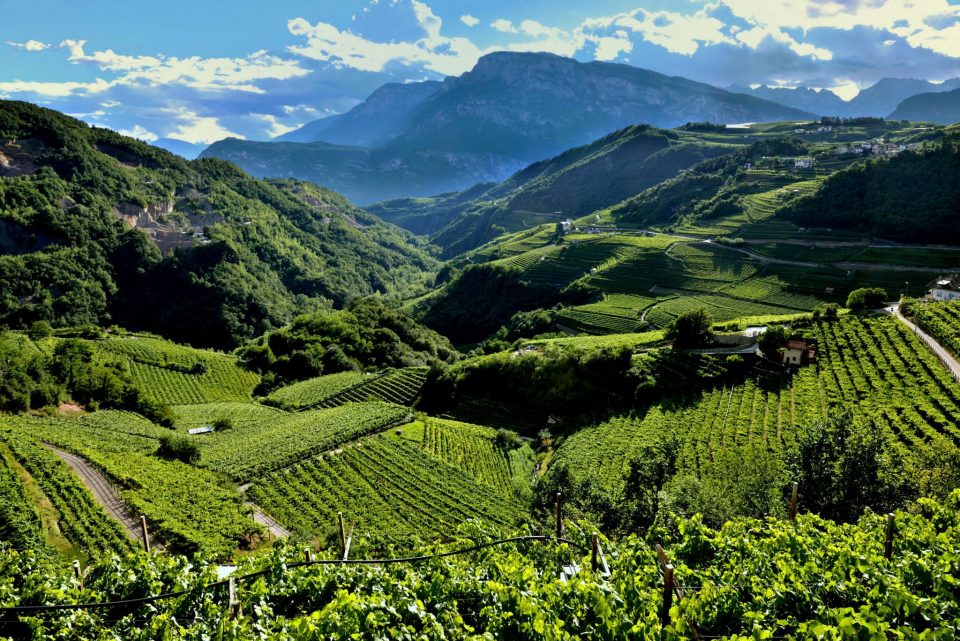Learning about wine
TrentoDoc

Trentodoc is a wine that fully represents the expression of its territory.
Despite its small size, Trentino is a treasure trove of beauties; different landscapes and a very specific climate that allows the production of a refined and elegant wine. In 1902 a young Giulio Ferrari sensed, during his experience made after studying oenology. a certain similarity with the Champagne area. In 1933 he produced the first wine and managed to set up it on Doc (the Trento Doc). Today there are many small realities that, with great strength and elegance, carry on the legacy of Mr. Ferrari.
Production
The base wine
The grapes used for the production of TrentoDoc are: Chardonnay, Pinot Noir, Pinot Bianco, Pinot Meunier. After the harvest, the basic still wine is wine made; once bottled, yeasts and sugars are added (tirage). After bottling, it is put to rest in dark and silent cellars.
The sparkling process
The base wine develops the carbon dioxide which is responsible for the perlage; basically the bubbles and the “foam” the wine forms when pouring it in the glass. The aging on the lees of a TrentoDoc is defined by the disciplinary:
- Brut minimum 15 months
- Vintage minimum 24 months
- Reserve minimum 36 months
All wineries tend to extend the aging time on the yeasts with respect to what indicated by the disciplinary. They do it in order to refine even more the final product. The variation of the temperature range gives acidity to the grapes, and this guarantees the wine, the ability to evolve and last longher.
Remuage
This is the most characteristic and fascinating phase of the classic method. The goal is to collect the exhausted yeasts (sediments) in the neck of the bottle, and then eliminate them with the disgorgement.
- Traditional method
The bottles are placed upside down on typical wooden stands (pupitres), which facilitate this passage: the person in charge rotates and moves the bottles with great care, so that the residues collect towards the neck of the bottle. Please note an expert operator is able to turn thousands of bottles a day, with precise and effective gestures, handed down for generations.
- New method
Today many wineries use mechanized “pallet turners”, which achieve the same results.
Disgorgement.
After resting upside down on the pupitres, it is necessary to eliminate the exhausted yeasts using a technique called disgorgement. The disgorgement can be done in two ways:
- manual (a la volèè) on the fly: the bottles are manually opened one by one as the tradition requires. After eliminating the crown cap, the pressure formed inside the bottle, pushes out the no longer active yeasts deposited in the plastic cap positioned under the crown cap (bidule).
- mechanical (a la glace) with ice: it involves the mechanical freezing of the neck of the bottles. The pressure formed inside the bottle blows the frozen cork, thus eliminating the saturated yeasts.
During the disgorgement phased some wine is lot and need to be replace so that the bottle is full again; normally it is replaced with a mix of fine wine and sugar: the personal touch of the winemaker also known as the secret blend. It is called liquer d’expedition and it is what distinguishes the features of each label.
Production Areas
There are four areas
- Alta Valle dei Laghi : here you can find wines of great acidity thanks to the important temperature change between day and night and, the hot wind of Garda (Ora del Garda) that drives away the cold currents.
- Vallagarina: the lower area, below Trento; here the wines are more ferrous and mineral.
- Valle dell’Adige: offers wines of great minerality, thanks to the calcareous soil.
- Valle di Cembra: here the vines grown at 600/800 m above sea level and here you find wines of great freshness and gustatory tension.
Nice to know
The two O’s of the TrentoDoc brand represent the remuage phase, an art typical of the Champagne method.





